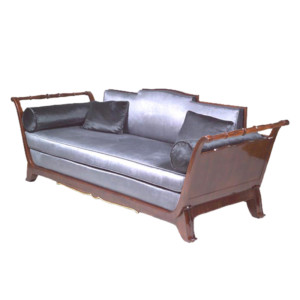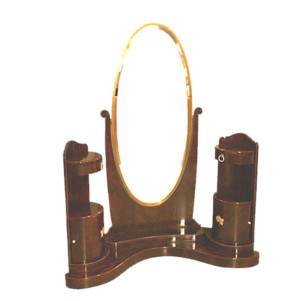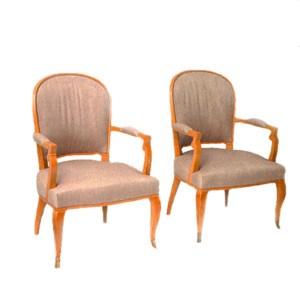(1883 – 1961)
LITERATURE: ART DECO FURNITURE, Alistair Duncan, pp118-119; ART DECO, Victor Arwas, pp 301-302
Tending to the Legacy of a Deco Master, Wendy Moonan, The New York Times, May 2008.
Jules Leleu was born in Boulogne-sur-Mer, a suburb of Paris. He was born into an old family tradition – the House of Leleu had been in existence dating back to the 18thcentury, but had, over time, lost much of their luster. The great talents of Jules, and later, his children, would bring the family name to prominence once again.
Jules was interested in sculpture and design, and he studied sculpture with Théophile Deman. He began showing his sculptures in 1905 at the SAF. At around this time, he, along with his brother Marcel, took over the family painting business from their father. They added a workshop and showroom to execute and display their own designs.
Both Jules and Marcel were drafted to fight in WW1 in 1914, where Jules was in the Air Force, and it was after he returned home, in 1918, that he decided on designing and making furniture as his calling. Soon, Jules was showing his furniture at several of the important and influential Salons in Paris. He participated in the Salon d’ Automne in 1922, and two years later, opened a gallery on avenue Franklin Roosevelt, while his brother Marcel attended to the work shop, where, in addition to furniture, they designed and produced rugs, lamps, and even designed their own fabrics. The highly important rug designer da Silva Bruhns worked closely with Jules, designing striking rugs to compliment the furniture.
Jules continued to exhibit at the important salons, and quickly gained a following. By 1929, he had moved his show room to Avenue Victor Emmanuel, while his brother Marcel was responsible for the production at the atelier.
Leleu exhibited at the prestigious 1925 Exposition des Arts Decoratifs, for which he designed the chairs for the Grand Salon and the Music Room, both part of the French Embassy Exhibition, and also exhibited a complete suite of furniture in his own space on the Esplanade des Invalides. He won a Grand Prize at the 1925 Exposition, and one of his pieces was purchased by the Metropolitan Museum in New York City.
His furniture was much admired for both its classical lines and its modernity – two seeming opposing ideas that Leleu was able to combine flawlessly to create his elegant and distinctive designs. His furniture was often compared with his more famous contemporary Emile Ruhlmann, and some of his work might seem to have been inspired by Ruhnmann.
Like Ruhlmann, Leleu used rare woods, ivory inlays, and other luxurious elements that were a hallmark of much Art Deco furniture, but a number of other Art Deco furniture designers used these luxurious materials as well. Wealthy clients wanted opulence, and incorporating there materials was one of the important features of Art Deco furniture. Leleu had his own distinctive and sophisticated style – often sober and reflective of traditional French furniture design, but also modern in line and use of materials, and always in good taste. His earlier pieces are often sensuously curved, but his forms gradually became more linear and restrained, influenced by the Modernism of the 1930’s.
Leleu favored the use of woods with warm tones, such as amboyna, Macassar ebony, walnut and palisander, which imparted richness, even for pieces that were not otherwise embellished with inlays or coverings of sharkskin or parchment, which were also much used by the best designers of the time.
Lacquer, introduced in France in the 1920’s, had also become a very important decorative element. Lacquer using natural materials is very difficult and demanding to work with, and as the resin used is related to poison ivy, could cause rashes and other allergic reactions to those working with it. It also had to be applied in thin layers, which had to dry and be sanded perfectly smooth before another layer could be applied, and many layers were required for the desired effect.
As these techniques had been brought to France from the Orient, Leleu employed Oriental craftspeople for this work. Hamanaka, one of the great masters of lacquer work, and the famed Jean Dunand, who had learned the skills from Hamanaka, collaborated with Leleu on pieces where lacquer was an element.
Leleu was very prolific, and was also constantly evolving and developing his styles. The awards that he won brought him many important clients and commissions, including the ocean liners Ile de France and the famed and ill-fated Normandie. Among other important commissions were a dining room for the Elysée Palace, and, later on, the Grand Salon des Ambassadeurs at La Societé des Nations in Geneva, which was called the Salon Leleu, and is still in existence.
Going into the 1930’s, his style changed to reflect the new Modernism, which evolved from Art Deco. Forms became more simplified and geometric, with mirrored glass elements, and more emphasis on chromed or nickel-plated elements. In the late 1930’s he introduced pieces with etched glass elements designed by Schwartz.
By this time, Leleu’s family had become involved in the business – his sons André and Jean, his daughter Paule, and even his wife were involved. By the 1950’s they were making a very different style of furniture – simple linear designs using synthetic lacquers in bright colors, sometimes with subtle designs and iridescence in the lacquer, and using other new materials like plastics and fiber glass, and using steel or aluminum. When he retired, his sons took over the business. Leleu died in 1961, leaving a legacy of elegant, refined and often surprisingly original work, and his pieces are highly sought after today.
Showing all 3 results




